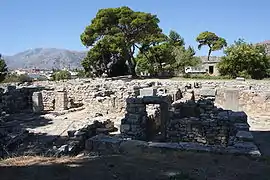Tylissus or Tylissos (Greek: Τύλισσος), or Tylisus or Tylisos (Τύλισος), was a town of ancient Crete.[1] On its ancient coins are found on the reverse a young man holding in his right hand the head of an ibex or wild goat, and in his left a bow.

References
- ↑ Pliny. Naturalis Historia. Vol. 4.20.
- ↑ Richard Talbert, ed. (2000). Barrington Atlas of the Greek and Roman World. Princeton University Press. p. 60, and directory notes accompanying.
- ↑ Lund University. Digital Atlas of the Roman Empire.
![]() This article incorporates text from a publication now in the public domain: Smith, William, ed. (1854–1857). "Tylissus". Dictionary of Greek and Roman Geography. London: John Murray.
This article incorporates text from a publication now in the public domain: Smith, William, ed. (1854–1857). "Tylissus". Dictionary of Greek and Roman Geography. London: John Murray.
35°17′55″N 25°01′14″E / 35.2985°N 25.02044°E
This article is issued from Wikipedia. The text is licensed under Creative Commons - Attribution - Sharealike. Additional terms may apply for the media files.